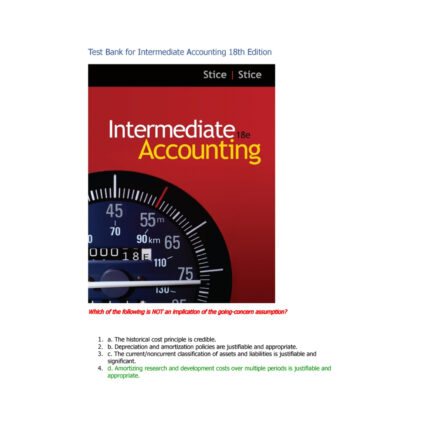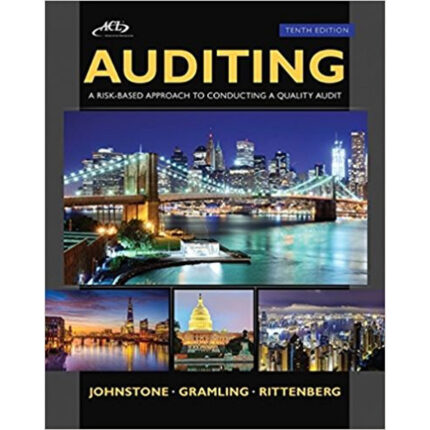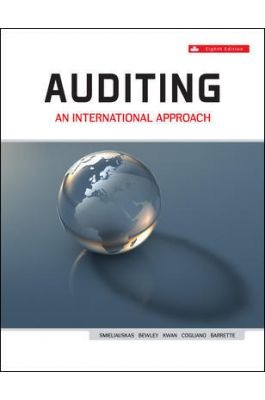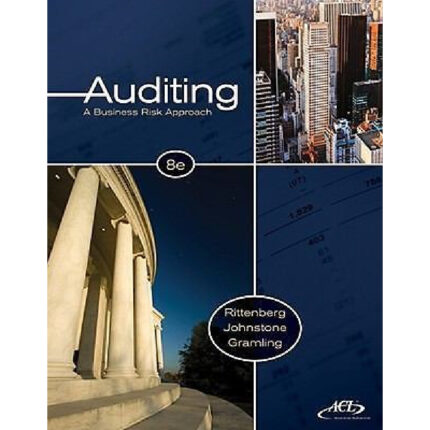Auditing And Assurance Services In Australia 7th Edition By Grant Gay – Test Bank
Chapter 11 Testbank Key
1. Which of the following statements is correct?
A. The auditor is responsible for ensuring that events occurring up to the date of the annual general meeting are reflected in the financial report.
B. The date of the auditor’s report establishes the date of the auditor’s responsibility for knowledge of events that should be reflected in the financial report.
C. The auditor’s report should be dated the same date as the annual general meeting.
D. The only procedures that should be performed after balance date are analytical procedures.
AACSB: Analytic
Difficulty: Medium
Learning Objective: 11.01 Explain the significance of the date of the auditor’s report.
Topic: The date of the auditor’s report
2. Analytical procedures used in the overall review stage of an audit generally include:
A. gathering evidence concerning account balances that have not changed from the prior year.
B. considering unusual or unexpected amount balances that were not previously identified.
C. retesting control procedures that appeared to be ineffective during the assessment of control risk.
D. testing transactions to corroborate management’s financial report assertions.
AACSB: Analytic
Difficulty: Medium
Learning Objective: 11.01 Explain the significance of the date of the auditor’s report.
Topic: The date of the auditor’s report
3. Which of the following procedures is least likely to be performed before the balance date?
A. Assessment of control risk for cash disbursements.
B. Observation of inventory.
C. Confirmation of receivables.
D. Search for unrecorded liabilities.
AACSB: Analytic
Difficulty: Medium
Learning Objective: 11.01 Explain the significance of the date of the auditor’s report.
Topic: The date of the auditor’s report
4. An auditor should obtain evidential matter relevant to all the following factors concerning third-party litigation against a client except the:
A. period in which the underlying cause for legal action occurred.
B. probability of an unfavourable outcome.
C. jurisdiction in which the matter will be resolved.
D. existence of a situation indicating an uncertainty as to the possible loss.
AACSB: Analytic
Difficulty: Easy
Learning Objective: 11.02 Define subsequent events of audit interest, and describe the audit procedures applied specifically to identify such events.
Topic: Subsequent events
5. An auditor is concerned with completing various phases of the examination after the balance date. This ‘subsequent period’ for audit testing extends to the date of the:
A. final review of the audit working papers.
B. auditor’s report.
C. delivery of the auditor’s report to the client.
D. public issuance of the financial report.
AACSB: Analytic
Difficulty: Easy
Learning Objective: 11.02 Define subsequent events of audit interest, and describe the audit procedures applied specifically to identify such events.
Topic: Subsequent events
6. A major customer of an audit client suffers a fire just after year-end and the audit client believes that this event could have a significant direct effect on the financial report. The auditor should:
A. advise management to disclose the event in notes to the financial report.
B. disclose the event in the auditor’s report.
C. withhold submission of the auditor’s report until the extent of the direct effect on the financial report is known.
D. advise management to adjust the financial report.
AACSB: Analytic
Difficulty: Medium
Learning Objective: 11.02 Define subsequent events of audit interest, and describe the audit procedures applied specifically to identify such events.
Topic: Subsequent events
7. Which of the following procedures would an auditor most likely perform to obtain evidence about the occurrence of subsequent events?
A. Investigate changes in shareholders’ equity occurring after year-end.
B. Recalculate a sample of large-dollar transactions occurring after year-end for arithmetic accuracy.
C. Confirm bank accounts established after year-end.
D. Enquire of the entity’s solicitor concerning litigation, claims and assessments arising after year-end.
AACSB: Analytic
Difficulty: Medium
Learning Objective: 11.02 Define subsequent events of audit interest, and describe the audit procedures applied specifically to identify such events.
Topic: Subsequent events
8. Which of the following procedures would an auditor most likely perform to obtain evidence about the occurrence of subsequent events?
A. Comparing the financial report being reported on with those of previous period.
B. Confirming a sample of material accounts receivable established after year-end.
C. Enquiring as to whether any unusual adjustments were made after year-end.
D. Investigating personnel changes in the accounting department occurring after year-end.
AACSB: Analytic
Difficulty: Easy
Learning Objective: 11.02 Define subsequent events of audit interest, and describe the audit procedures applied specifically to identify such events.
Topic: Subsequent events
9. After an auditor has issued an auditor’s report on the financial report, there is no obligation to make any further audit tests or enquiries with respect to the audited financial report covered by that report unless:
A. new information comes to the auditor’s attention concerning an event that occurred prior to the date of the auditor’s report that may have affected the auditor’s report.
B. material adverse events occur after the date of the auditor’s report.
C. final determination or resolution was made on matters that had resulted in a modification of the auditor’s report.
D. final determination or resolution was made of a contingency that had been disclosed in the financial report.
AACSB: Analytic
Difficulty: Medium
Learning Objective: 11.02 Define subsequent events of audit interest, and describe the audit procedures applied specifically to identify such events.
Topic: Subsequent events
10. Which of the following auditing procedures is ordinarily performed last?
A. Reading the minutes of the directors’ meetings.
B. Confirming accounts payable.
C. Obtaining a management representation letter.
D. Testing the purchasing function.













Reviews
There are no reviews yet.